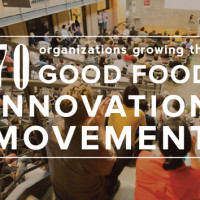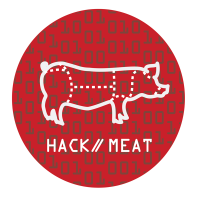From June 21-23 at the Stanford d. school Food+Tech Connect, in partnership with the GRACE Communications Foundation and Applegate, is bringing together technologists, entrepreneurs, creatives, advocates and industry executives to develop technologies that help bridge the divide between pasture and plate. Over the course of the weekend, teams will work with design-thinking facilitators and industry “steakholders” to rapidly prototype innovative solutions to the way meat is produced, processed, distributed, sold and consumed. Learn more about our expert judges and mentors here and our prizes (valued at a combined $100k) here.
To help you prepare for Hack//Meat Silicon Valley, we’ve compiled an overview of the Steakholder challenges below.
You can view the steakholder challenge briefs in full here.
**We are looking for more resources to enable our hackers to build something really transformative at Hack//Meat Silicon Valley. Have a relevant API or data to share for any of these Hack//Meat challenges? Get in touch with us or share in the comments below.**
You can change the future of meat – no prior food experience necessary – Sign up today.
THE CHALLENGES
Applegate: How can the next generation of farmers meet growing demand for sustainably-produced meat?
There is tremendous demand from the CPG and food service sectors for sustainably raised meat, but supply has not caught up and this is an enormous barrier to growth. Rather, farmers are a dwindling population – by 2030 half a million farmers (1/4) will retire and young farmers are not entering the profession at replacement rates.
Securing land is a significant barrier to farming – costs are high and finding the right piece of land can take a farmer years. Renting land can prevent farmers from undertaking more investment-heavy animal husbandry, rather than row crops, which are cheaper to start off with.
Can we design a tool that makes it easier for young farmers to find land available for long-term farming and unify a fragmented information landscape? Can we draw information from a variety of databases and resources, and encourage people to list their land? Can we provide an easy way to connect farmers with land, wherever it is?
Natural Resources Defense Fund (NRDC), in partnership with GRACE Communications Foundation: How can we find, recruit and empower a million consumer activists to demand meat without antibiotics?
Eighty percent of all antibiotics sold in the U.S. are for livestock use, mostly for growth promotion and to compensate for unsanitary, crowded, stressful living conditions. Repeated use of these life-saving drugs for animals is breeding antibiotic resistant bacteria, also known as superbugs, which increasingly threaten people’s health and jeopardizes the efficacy of medicine.
Last year, a federal court sided with NRDC and ordered FDA to begin cancellation proceedings for two important classes of antibiotics and to evaluate the safety of others. But FDA has since appealed and the outcome is still pending. Now it’s time to take our case to the court of public opinion where consumers can influence the most powerful food companies.
We know that many consumers are concerned about the use of antibiotics in animal feed, according to a Consumer Reports study published last March. We also know that the market is powerful. Supermarkets and consumers can shift antibiotic use in animals through their purchasing decisions. So how can we find, recruit and empower a million consumer activists to demand meat without antibiotics?
Butcher’s Guild: How can we make whole animal butchery more profitable through tracking?
The whole animal butcher shop/plant/restaurant faces a unique inventory and costing challenge. When buying a whole animal, you use different parts of the animal in different categories (or departments, or uses, depending on the jargon of the store) and it can be practically impossible to track the efficiency, profitability and cash flow of a piece of meat. It’s important to be able to track the cuts of meat for traceability reasons and to understand the financial impact of each process.
The one thing every butcher has (besides meat, and knives, and…) is a scale. Most scales have a computer that stores information, like item names, PLUs and costs. Could we create a software program to manage and create insights from this scale data? How can we help butchers could weigh a piece of meat and then enter its new department. I.e. a butcher would take that chuck that was going into grind and weigh, then enter that it was now ready-to-cook burgers?
American Grassfed Association: How Can We Create Transparency in the Bulk Buying Process for Consumers, Producers, and Processors?
Many small family farms market their meat products directly to consumers and offer more attractive pricing for buying in bulk, i.e. whole or partial animals. Consumers have a hard time visualizing the amount of space a bulk purchase requires and don’t understand the difference between terms like live weight, hanging weight and finishing weight. And because most have very little understanding of animal anatomy and terminology, it’s difficult to order cuts that they’ll actually use. A common complaint is that a beef quarter is nothing but a few roasts and a bunch of ground meat, but that doesn’t need to be the case. Currently, ordering is done via paper or online form with very little information and education for consumers. The current system is rife with communications difficulties and misunderstandings among producers, consumers and processors.
James Beard Association: How can we celebrate the unique flavors of grassfed meat?
Chefs have a difficult time cooking with grassfed meat because of variability of taste, quality and cuts, which can change based on terrior, breed, processor and season. Many also lack experience with preparing grassfed beef, which requires different preparation methods than corn-fed beef. Finally, US eaters prefer the taste of corn-fed meat, which makes it difficult for chefs to justify serving it.
Like wines from different regions, the unique taste profiles of meats could be something that is celebrated, but first it needs to be understood.
How can we map the taste of meat from different regions, breeds and seasons to help farmers and chefs understand how to maximize deliciousness? Instead of working against variation, can we leverage place, breed and season to maximize deliciousness? Can localized, crowd-sourced, deeper grading on cuts of meat to help give chefs deeper knowledge of the meat coming in so that they can handle and prepare it more easily and so we all have a better vocabulary to describe and enjoy meat with?
Currently, we treat meat like a widget; we often strive to create consistency in order to facilitate pricing, menus and to accommodate scale. We used to celebrate food for its unique, exotic flavors, but often now try to erase local variability in the interest of predictability.
Local, seasonal food has local and seasonal tastes. Our palates have changed to prefer non-seasonal, corn-fed, dry aged beef, and need to be thoughtfully readjusted.
Niche Meat Processors Assistance Network (NMPAN): How can we help producers and processors better communicate and improve efficiencies?
Bringing local meat and poultry to market requires access to appropriately scaled processing facilities. Farmers and others suggest that limited processing infrastructure restricts the supply of local meat and poultry but at the same time, existing small processors often lack the steady, consistent business they need to be profitable. New processing ventures built specifically to handle local product often do not survive.
Farmers and processors often have relationships of convenience, but farmer commitment (individually or in coordinated groups or brands) is essential in providing the processor with a sufficient, steady supply of livestock to process. Steady business generates steady revenue, which is fundamental to long-term processor viability.
Business commitments between processors and farmers are critical to mutual success: farmers commit to providing consistent throughput of livestock to process, and processors commit to providing consistent, high-quality processing services. This commitment, supported by coordination and communication between processors and their customers as well as along the entire supply chain, is essential to the persistence and expansion of local meats.
Shifting toward commitment, away from convenience, is the key factor in maintaining and expanding processing for local meats. In general, a lack of throughput is likely a more limiting factor for local meats than a lack of processing capacity. Unless stronger relationships of commitment can be formed farmers cannot grow because processing capacity is limited, and processors cannot grow or provide certain services or availability because they do not have enough steady work to provide steady revenue.







